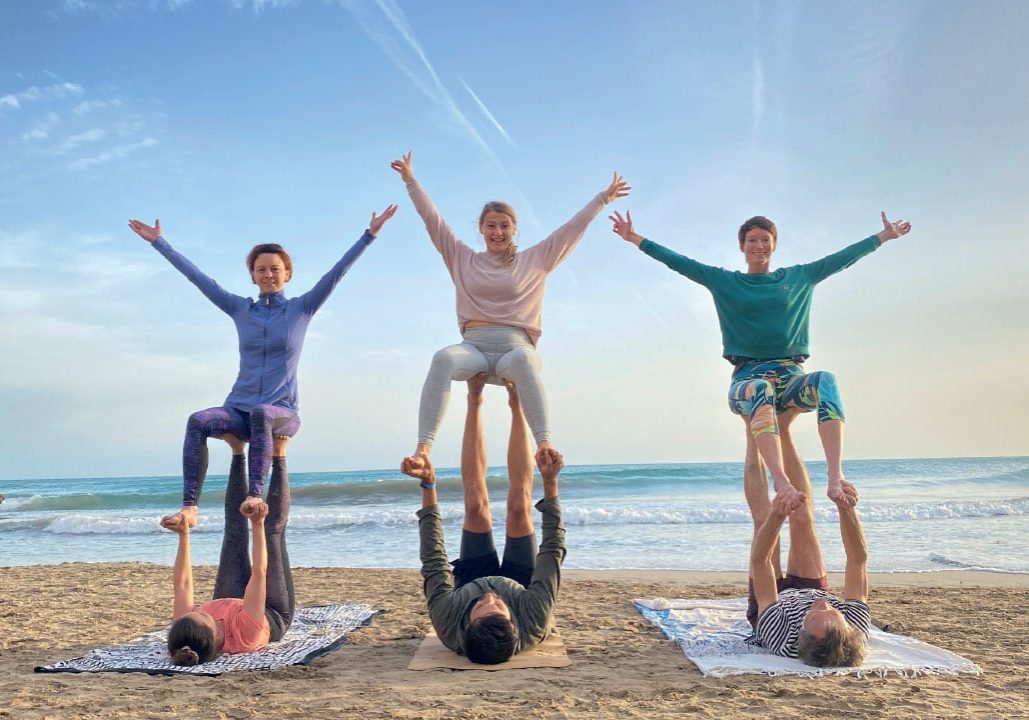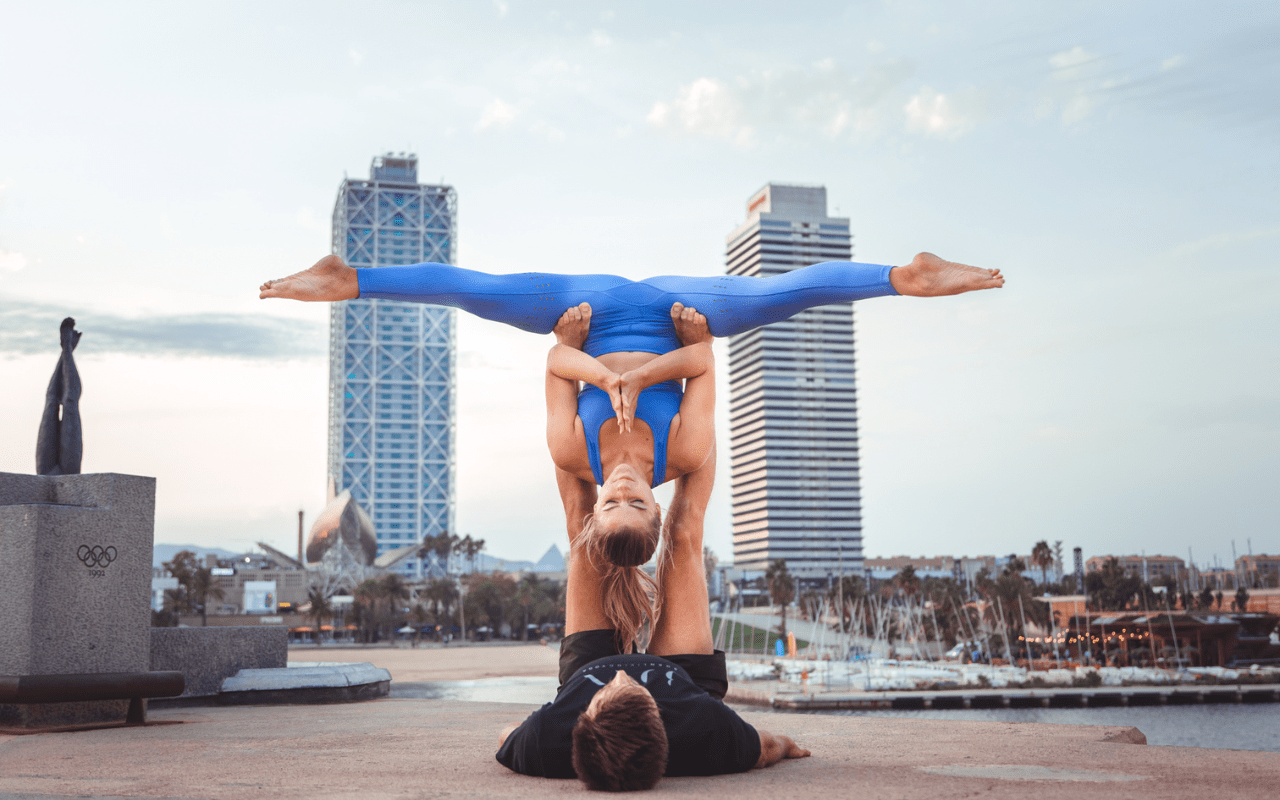
The 6 learnings of acroyoga
Six additional things you may learn together in acroyoga beyond the poses. By Sergio Villena Kirchhartz
Acroyoga isn't just a physical exercise that combines yoga poses and acrobatics with a partner. As with all yoga styles (and indeed many other physical practices) there are additional learnings associated with it. These might not be as crystal clear as the nice pictures and poses, but these skills might hold even more impact in real life. Additionally, one of the strengths of acroyoga is that you will be practicing all these learnings together with someone else, perhaps someone very close to you. So these learnings will not only have impact on yourself but in your relationship with this person too.
The following six learnings aren't sorted by importance. Depending on your own experience and partner relationship, some of them will have more impact on your daily life than others.
1. Confidence
In our daily lives, sometimes we must trust people that we almost don't even know, not just our partners and friends, but perhaps work colleagues or even institutions. It changes by culture, age or person, perhaps, but in the end there are a set of predefined rules. We are used to trusting people in two key areas: time and money. For instance, we expect that our partner will come on time for the wedding anniversary dinner or that our friends will show up on time for the game on Sundays. Similarly, with money, we work for others because we expect to be paid at the end of the month as agreed; or we lend money to a friend because he/she promises to pay the money back as soon as they can.
Acroyoga learning
In class, besides these types of confidence (obviously, teachers and students are expected to start classes on time and for the agreed exchange of the economic class value), we learn in another very important way: physical confidence. In our daily lives, we rarely have the opportunity to place all our physical integrity in the hands or feet of someone else. During acroyoga, both partner and flyer learn how to trust one another by giving part of their body integrity to the other.
2. Communication
We've all had the experience of being a driver or the navigator through an unknown city and making a mess with the directions, ending up in a stressful situation and probably arriving later than expected at a destination. Who was guilty of it? Let's not get into that discussion! Instead, we can learn something here from acroyoga.
Acroyoga learning
During the training, communication flows at a different level than in real life. First of all, we put ourselves consciously in a stressful situation; we will be hanging upside down or strengthening our legs to the max of our power. Secondly, we will have a different point of view: the flyer's left hand will be the base's right hand, for instance, or for the base to go back could mean for the flyer to bend to the opposite direction. In acroyoga, we learn to use the appropriate words, as well as other tools (like touch or tricks) to cope with the situation and perform in the best possible way, which can require clear and sometimes almost intuitive communication.
3. Empathy
Empathy runs deeps through all strands of life nowadays, affecting how we perform in our work as well in our private relationships, from friends to the total strangers that we encounter every day.
Acroyoga learning
Everyone starting with acroyoga will change roles from time to time. People love to do what they can perform the best, but by trying other roles we can learn even more. By doing so, we see what our partner needs to do so that we both can succeed. Moreover, we feel more connected to him/her because we see and understand their position both physically and mentally. Changing points of view can be transported to real life. We are used to living in our 'own world', without caring too much about others. By placing ourselves in another's shoes we can share together 'both worlds' and become just one reality, finding a new way to view the world. In acroyoga, try to change roles of the flyer and base at least once; in real life, make the effort each day to try to understand the feelings of others.

4. Stress management
Stress is often called the illness of the 21st century. We encounter it in many forms and in different environments. One way to face it is through yoga. With every pose, we consciously place ourselves in a stressful situation; in a headstand we are bringing both our body and mind to the limit, while the regular practice of yoga means we are better able to control the pose slowing our breath and bringing our mind to the present moment.
Acroyoga learning
Sometimes working together to face stressful situations can help. In acroyoga, we are no longer alone in performing our bow pose; we are working with someone else to rise and do bow pose, perhaps just centimetres from the ground. Additionally, we bring to our real life an added ability to cope with stress in teams or when others are involved. We will be able to respond consciously instead of reacting unconsciously. In real-world examples, that might mean we won't shout in an argument, and instead, we will hold our first reaction, work on our stimulus and then use a more thoughtful, appropriate response.
5. Teamwork
A couple, a group of friends, a family...these all are types of teams and each with different sets of rules. Anyone who has played on a sports team before, like a soccer or basketball team, knows what good working together can achieve on the pitch, but what can we learn from an acroyoga team?
Acroyoga learning
As a couple, or just friends, we are usually not used to playing as a team. In this case, acroyoga is a 100% team game; flyer and base both need to work together to master all poses. There is no place for stars on this team! Both bring to the mat their best version of themselves and when mistakes happen (and they will often happen, like falling or slipping) it is a group mistake. For example, if the flight went badly, it isn't only because the flyer's hip was too low, but perhaps also because the base was not placing their feet in the right place.
6. Goal orientation
How many times have you signed up for a fitness studio or similar and stopped going after a few weeks? How many times have we been working so hard and blindly towards a goal that when we achieved it, we realise that it wasn't what we were looking for?
Acroyoga learning
Acroyoga is an amazing path if you have the chance to walk it with someone you love or appreciate. For instance, sometimes you will wait and help your partner to gain flexibility; other days, you will be supported by another person to gain strength. The peer/partner relationship will make you continue practicing even in the worst conditions, and much more so than if you were to work alone towards a goal. This will be evident after the first class or practice, you will create together a strategy for achieving your goal: poses with arms, enhancing thigh flexibility, working on turns or jumping, for example. You will, as an individual and as a team, gain the patience and discipline to achieve whatever you desire on the mat.

Sergio Villena Kirchhartz created Yogitos with Zlata Kobas to share their passion for Acroyoga. Based near Barcelona, they welcome students from around the globe for many different retreat styles: yoga, surf, Spanish lifestyle and, of course, Acroyoga for all levels. Visit: yogaemotion.net or connect on Instagram @yogitos_zs




